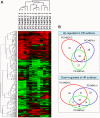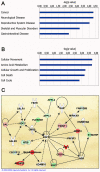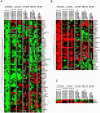Bypass mechanisms of the androgen receptor pathway in therapy-resistant prostate cancer cell models
- PMID: 20976069
- PMCID: PMC2957443
- DOI: 10.1371/journal.pone.0013500
Bypass mechanisms of the androgen receptor pathway in therapy-resistant prostate cancer cell models
Abstract
Background: Prostate cancer is initially dependent on androgens for survival and growth, making hormonal therapy the cornerstone treatment for late-stage tumors. However, despite initial remission, the cancer will inevitably recur. The present study was designed to investigate how androgen-dependent prostate cancer cells eventually survive and resume growth under androgen-deprived and antiandrogen supplemented conditions. As model system, we used the androgen-responsive PC346C cell line and its therapy-resistant sublines: PC346DCC, PC346Flu1 and PC346Flu2.
Methodology/principal findings: Microarray technology was used to analyze differences in gene expression between the androgen-responsive and therapy-resistant PC346 cell lines. Microarray analysis revealed 487 transcripts differentially-expressed between the androgen-responsive and the therapy-resistant cell lines. Most of these genes were common to all three therapy-resistant sublines and only a minority (∼5%) was androgen-regulated. Pathway analysis revealed enrichment in functions involving cellular movement, cell growth and cell death, as well as association with cancer and reproductive system disease. PC346DCC expressed residual levels of androgen receptor (AR) and showed significant down-regulation of androgen-regulated genes (p-value = 10(-7)). Up-regulation of VAV3 and TWIST1 oncogenes and repression of the DKK3 tumor-suppressor was observed in PC346DCC, suggesting a potential AR bypass mechanism. Subsequent validation of these three genes in patient samples confirmed that expression was deregulated during prostate cancer progression.
Conclusions/significance: Therapy-resistant growth may result from adaptations in the AR pathway, but androgen-independence may also be achieved by alternative survival mechanisms. Here we identified TWIST1, VAV3 and DKK3 as potential players in the bypassing of the AR pathway, making them good candidates as biomarkers and novel therapeutical targets.
Conflict of interest statement
Figures





Similar articles
-
Modulation of androgen receptor signaling in hormonal therapy-resistant prostate cancer cell lines.PLoS One. 2011;6(8):e23144. doi: 10.1371/journal.pone.0023144. Epub 2011 Aug 4. PLoS One. 2011. PMID: 21829708 Free PMC article.
-
Androgen receptor modifications in prostate cancer cells upon long-termandrogen ablation and antiandrogen treatment.Int J Cancer. 2005 Nov 1;117(2):221-9. doi: 10.1002/ijc.21201. Int J Cancer. 2005. PMID: 15900601
-
Androgen-regulated genes differentially modulated by the androgen receptor coactivator L-dopa decarboxylase in human prostate cancer cells.Mol Cancer. 2007 Jun 6;6:38. doi: 10.1186/1476-4598-6-38. Mol Cancer. 2007. PMID: 17553164 Free PMC article.
-
The role of the androgen receptor in the development and progression of prostate cancer.Semin Oncol. 1999 Aug;26(4):407-21. Semin Oncol. 1999. PMID: 10482183 Review.
-
Androgen receptor involvement in the progression of prostate cancer.Endocr Relat Cancer. 2003 Jun;10(2):209-16. doi: 10.1677/erc.0.0100209. Endocr Relat Cancer. 2003. PMID: 12790784 Review.
Cited by
-
Interactions between androgen and IGF1 axes in prostate tumorigenesis.Nat Rev Urol. 2024 Oct 7. doi: 10.1038/s41585-024-00942-3. Online ahead of print. Nat Rev Urol. 2024. PMID: 39375467 Review.
-
MK591, a second generation leukotriene biosynthesis inhibitor, prevents invasion and induces apoptosis in the bone-invading C4-2B human prostate cancer cells: implications for the treatment of castration-resistant, bone-metastatic prostate cancer.PLoS One. 2015 Apr 15;10(4):e0122805. doi: 10.1371/journal.pone.0122805. eCollection 2015. PLoS One. 2015. PMID: 25875826 Free PMC article.
-
Combination of Blood Adiponectin and Leptin Levels Is a Predictor of Biochemical Recurrence in Prostate Cancer Invading the Surrounding Adipose Tissue.Int J Mol Sci. 2024 Aug 17;25(16):8970. doi: 10.3390/ijms25168970. Int J Mol Sci. 2024. PMID: 39201655 Free PMC article.
-
Castration-resistant prostate cancer: mechanisms, targets, and treatment.Prostate Cancer. 2012;2012:327253. doi: 10.1155/2012/327253. Epub 2012 Mar 5. Prostate Cancer. 2012. PMID: 22530130 Free PMC article.
-
Expression and functional role of orphan receptor GPR158 in prostate cancer growth and progression.PLoS One. 2015 Feb 18;10(2):e0117758. doi: 10.1371/journal.pone.0117758. eCollection 2015. PLoS One. 2015. PMID: 25693195 Free PMC article.
References
-
- Crawford ED, Eisenberger MA, McLeod DG, Spaulding JT, Benson R, et al. A controlled trial of leuprolide with and without flutamide in prostatic carcinoma. N Engl J Med. 1989;321:419–424. - PubMed
-
- Eisenberger MA, Blumenstein BA, Crawford ED, Miller G, McLeod DG, et al. Bilateral orchiectomy with or without flutamide for metastatic prostate cancer. N Engl J Med. 1998;339:1036–1042. - PubMed
-
- Jenster G. The role of the androgen receptor in the development and progression of prostate cancer. Semin Oncol. 1999;26:407–421. - PubMed
-
- van der Kwast TH, Schalken J, Ruizeveld de Winter JA, van Vroonhoven CC, Mulder E, et al. Androgen receptors in endocrine-therapy-resistant human prostate cancer. Int J Cancer. 1991;48:189–193. - PubMed
Publication types
MeSH terms
Substances
LinkOut - more resources
Full Text Sources
Medical
Molecular Biology Databases
Research Materials

